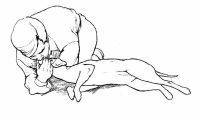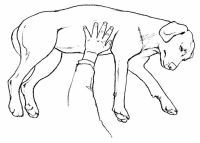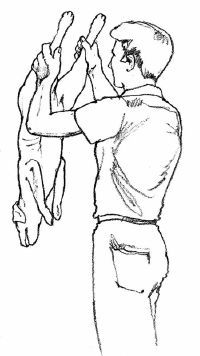How to Treat a Choking Dog
When a dog is choking on a foreign object, it needs help at once. The harder it tries to breathe, the more panicky it becomes. Your goal in this emergency situation is to open the dog's airway without being bitten.
The signs that a dog is choking include pawing at the mouth, a pale or blue tongue, obvious distress, or unconsciousness. If the dog is unconscious and you believe a foreign object is present, you must open the airway before giving the dog cardiopulmonary resuscitation (CPR). If the dog cannot breathe, efforts to revive it will be fruitless.
Advertisement
While all this sounds quite overwhelming, you can help a choking or unconscious dog by following the basic tips outlined below. Your efforts may save a dog's life!
Step 1: Restrain the dog if necessary.
Step 1a: Approach the dog slowly, speaking in a reassuring tone of voice.
Step 2: Clear the airway.
Step 2a: Open the dog's mouth carefully by grasping the upper jaw with one hand over the muzzle.
Step 2b: Press the dog's lips over the upper teeth by pressing your thumb on one side and your fingers on the other so that the lips are between the dog's teeth and your fingers. Apply firm pressure to force the mouth open.
Step 2c: If you can see the object, try to remove it with your fingers.
Step 2d: If you cannot remove the object and the dog is small enough, pick it up by grasping its back legs; turn it upside down and shake vigorously. Slapping its back while shaking may help to dislodge the object.
Step 2e: If you cannot remove the object and the dog is too large to pick up, place the dog on its side on the floor. Place your hand just behind the rib cage and press down and slightly forward quickly and firmly. Release. Repeat rapidly several times until the object is expelled.
Step 3: If you cannot dislodge the object, transport the dog immediately to the veterinarian.
Step 4: If you dislodge the object and the dog is not breathing, feel for a heartbeat by placing your fingers about 2 inches behind the dog's elbow in the middle of its chest.
Step 5: If the dog's heart is not beating, proceed to Step 6. If it is, perform artificial respiration.

Step 5a: Turn the dog on its side.
Step 5b: Extend the dog's head and neck. Hold the dog's mouth and lips closed and blow firmly into its nostrils. Administer 1 breath every 3 to 5 seconds. Take a deep breath, and repeat until you feel resistance or see the chest rise.
Step 5c: After 10 seconds, stop. Watch the chest for movement to indicate the dog is breathing on its own.
Step 5d: If the dog is not breathing, continue artificial respiration.
Step 6: If the heart is not beating, perform CPR.
CPR for Dogs Weighing up to 45 Pounds
Step 6a: Turn the dog on its back.

Step 6b: Kneel down at the head of the dog.
Step 6c: Clasp your hands over the dog's chest with your palms resting on either side of its chest.
Step 6d: Compress your palms on the chest firmly for a count of "2," and release for a count of "1." Moderate pressure is required. Repeat about 60 to 90 times per minute.
Step 6e: Alternately (after 30 seconds), hold the dog's mouth and lips closed and blow firmly into its nostrils. Blow for 3 seconds, take a deep breath, and repeat until you feel resistance or see the dog's chest rise. Try to repeat this 10 to 20 times per minute. As a general rule, use a CPR ratio of about 5 heart compressions to 1 breath of air.
Step 6f: After 1 minute, stop. Look at the chest for breathing movement, and feel for a heartbeat by placing fingers about 2 inches behind the dog's elbow in the center of its chest.
Step 6g: If the dog's heart is not beating, continue CPR. If the heart starts beating, but the dog is still not breathing, return to Step 5.
CPR for Dogs Weighing More Than 45 Pounds

Step 6a: Turn the dog on its side.
Step 6b: Place the palm of your hand in the middle of the dog's chest.
Step 6c: Press for a count of "2," and release for a count of "1." Firm pressure is required. Repeat about 60 to 90 times per minute.
Step 6d: Alternately (after 30 seconds), hold the dog's mouth and lips closed and blow firmly into its nostrils. Blow for 3 seconds, take a deep breath, and repeat until you feel resistance or see the chest rise. Try to repeat this 10 to 20 times per minute.
Step 6e: After 1 minute, stop. Look at the chest for breathing movement, and feel for a heartbeat by placing your fingers about 2 inches behind the dog's elbow in the center of its chest.
Step 6f: If the dog's heart is not beating, continue CPR. If the heart starts beating but the dog is still not breathing, return to Step 5.
Step 7: Transport the dog immediately to the veterinarian. CPR or artificial respiration should be continued on the way to the veterinarian or until dog is breathing and its heart is beating without assistance.
Witnessing a seizure can be a scary thing, but don't panic. Use the tips on the next page to help you if your pet experiences convulsions or seizures.
